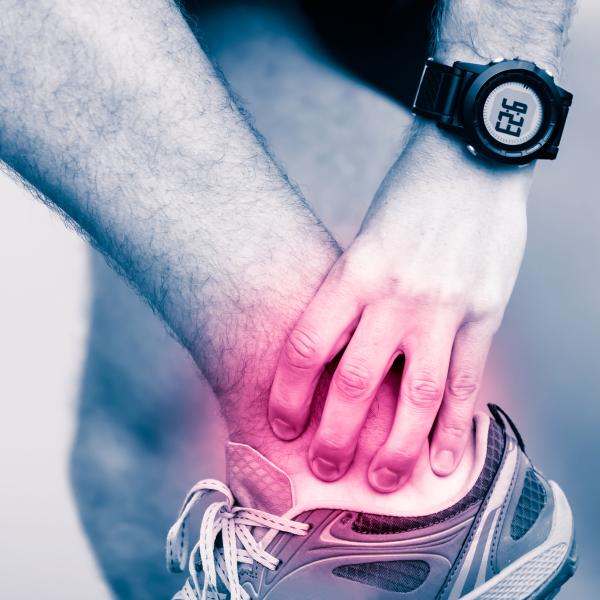
Ankle pain can make regular daily activities seem like a challenge. The pain can be caused by an injury or inflammation of any of the structures in the ankle region. Read on to learn more about common causes, conditions, injury prevention and rehabilitation.
Get Your Free Physical Therapy Screening
Interested in physical therapy for your ankle problem? Get a free screening and let us help you start the path to recovery today.
GET MY COMPLIMENTARY SCREENING
Common Causes
An ankle injury occurs when the ankle joint is twisted too far out of its normal position. In addition to wearing faulty footwear, an ankle injury can happen as a result of:
- Twisting or rotating the ankle (this could be from a trip or fall)
- Landing awkwardly after jumping
- Rolling the ankle while walking or running
- A sudden impact
- Twisting the ankle side to side (commonly seen in athletes making quick direction changes)
- Applying severe force to the joint (this could be caused by jumping from a high level and coming straight down on it)
Common Conditions
Ankle pain can be caused by any one of these common conditions:
- Tendonitis – Inflammation/irritation of a tendon in the ankle (Achilles, peroneal and/or tibial)
- Arthritis – Osteoarthritis, rheumatoid, psoriatic and septic arthritis can affect any joint, including the ankle
- Fractures – A break in any of the three bones in the ankle (tibia, fibula, and talus)
- Sprains – Damage to ligaments in the ankle when they are stretched beyond their normal range of motion
- Strains – Damage to muscles and tendons in the ankle as a result of being pulled or stretched too far
- Gout – A form of arthritis in which crystals periodically deposit in joints which can cause severe pain and swelling
Injury Prevention
When it comes to any injury, prevention is key. ATI's Jane Cobler, PT, DPT, gives us some tips to help prevent and rehabilitate ankle injuries:
- Warm up – Proper warm up is key, especially if you have been sedentary/at work all day.
- Flexibility – You need proper flexibility in your foot/ankle to prevent excessive stress on your joints and ligaments, especially for people who wear heels at work all day – remember to stretch those calves!
- Strength – You would be surprised how weak people’s ankles can be; it’s not traditionally an area people think to “strengthen” until they are in rehab.
- Proper Footwear – Wear the right footwear for your foot and your activity. You will want the correct shoes to support your own foot’s individual shape and mobility. And choose the right shoe for the right activity – i.e., don’t use a running shoe to play tennis (running requires movement primarily in the forward-to-back (sagittal) plane vs. tennis/basketball that requires a lot of cutting, pivoting and lateral movements – shoes are designed to provide the right kind of support for this).
- Balance – Great balance will keep your foot/ankle “ready” for those unexpected stumbles or uneven surfaces when you are walking or exercising.
Rehabilitation
If you have pain in your ankle that isn't going away, rehabilitation could be the next step. Many of the same inury prevention principles above still apply, but usually it’s a deficit in these areas that we find in therapy, so we will address them:
- Control Swelling and Inflammation – Initially, we will control swelling and inflammation by using a variety of techniques such as gentle soft tissue work, gentle mobility and range of motion, ice and other modalities.
- Strength – Foot/ankle strength as well as strength in the joints above. Remember, your body moves as a functional unit and not in isolation, so if there is a big deficit in strength higher up, for example your hips, it can translate to creating abnormal stresses down below.
- Mobility – Address any areas that are not mobile enough at the joint-level with joint mobilization and soft tissue techniques.
- Balance and Proprioception (joint position sense) Training – Balance, like strength, can improve – it takes challenging your balance system to improve it, so your therapist will likely have you practice doing things like exercises on uneven/unstable surfaces, changing your foot position/base of support, and apply external perturbations to do this.
- Progress – Usually start with single-plane motions (i.e. forward/back, side-to-side), then introduce rotational challenges, and finally progress to functional movement patterns and higher level activities like jumping, cutting, and pivoting.
When weighing your treatment options for ankle pain, consider physical therapy. Physical therapy offers a wide variety of treatment options including strengthening, flexibility assessments, and sustainable home exercise programs. Stop in or call any ATI location for a complimentary injury screen or to learn more about how physical therapy can help you overcome your ankle pain. Click here to schedule a complimentary injury screen.
Pain, Strain or Sprain...We're Here for You!
References:
